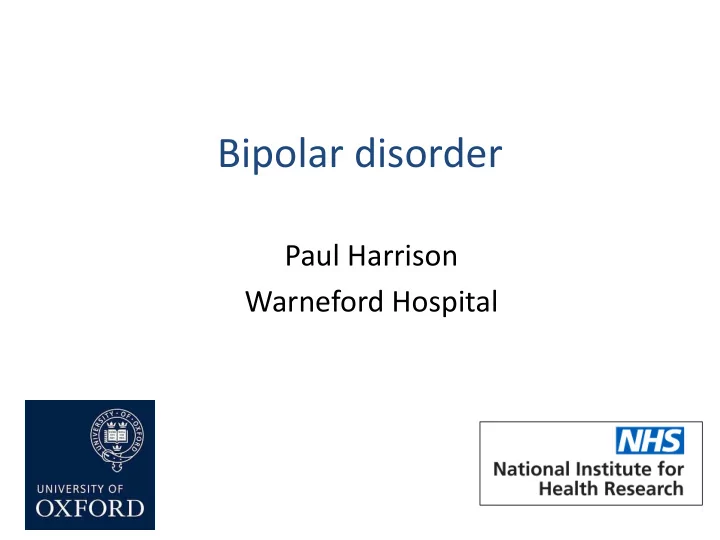

Bipolar disorder Paul Harrison Warneford Hospital
Bipolar disorder guidelines • NICE (2014) • British Association for Psychopharmacology (Goodwin et al, 2016, J. Psychopharmacol . 30: 495-553) – Covers all aspects – Independent – Available free from website: https://www.bap.org.uk/guidelines • Also BAP guidelines for psychotropic prescribing in pregnancy/breastfeeding (2017), and off-label prescribing (2017)
Troublesome terms • Mania vs hypomania – Mania = mood elevation etc, with functional impairment. – Hypomania = mood elevation (and increased energy) unequivocal, but it does not cause marked functional impairment – Both need to be present for 7 days (though DSM-5 requires only 4 days for hypomania) • Bipolar I vs Bipolar II – American (DSM) terms – BD1 = ‘true’ BD, with mania – BD2 = milder BD, with hypomania (and depression).
Majority of BD presents with one or more depressive episodes first, so how to spot BD? • Screening for undiagnosed past hypomania – Episode(s) of increased energy/disinhibition/reduced sleep/grandiosity/irritability – Out-of-character/caused problems/regretted – How long? – Was patient on an antidepressant/stimulant at the time? • Family history of BD
• Differential diagnosis – Borderline PD (emotionally unstable PD) – Cyclothymia – ‘Organic’ bipolar disorder • Especially if onset >40, unexpected • Steroids, L-DOPA, thyroid, cortical lesions – Schizoaffective disorder – (A ‘degree’ of BD) • Comorbidities/confounders – The rule not the exception – Alcohol and drugs – Anxiety disorders • Often persistent, and not explained by mood
BD vs borderline PD (BPD) • Distinguishing features of BPD – Personality not illness – Pervasive efforts to avoid abandonment – Features fluctuate in response to relationships, e.g. ‘acting out’ and anger – Chronic feeling of emptiness, depressive symptoms, poor self-image – Absence of true hypomanic episodes – (Differences in characteristics of mood instability) • Comorbid in 20% – Worse outcomes – BPD ‘blinds clinician to diagnosis of BD’ (and its therapy) – Presence of BPD increases case for psychotherapy
Bipolar depression • Causes far more morbidity than the manic phase • SSRIs (and other antidepressants) are largely ineffective and may precipitate hypomania or rapid cycling • Hence recognition of bipolarity is important, as leads to different treatment algorithm • Clinically similar to unipolar depression, but – Melancholic, psychotic, or atypical features raise suspicion – Plus family history and past history mentioned earlier
Drug treatment of bipolar depression First Olanzapine Fluoxetine + Quetiapine line olanzapine Second Fluoxetine + Quetiapine Lamotrigine Quetiapine + line olanzapine lamotrigine
Bipolar depression (2) • Quetiapine: – Strong evidence – (A bit) less weight gain/metabolic syndrome than olanzapine – Anxiety and sedation – Dose varies widely • Start low, warn about sedation • Often <300mg/d needed
Bipolar depression (3) • Lamotrigine – Reasonable effect as sole agent – Useful adjunct if first-line Rx ineffective – Well tolerated – But slow titration, risk of Stevens-Johnson syndrome – CHC • Reduces lamotrigine levels (so risks of toxicity in pill-free week) • Either avoid CHC, or use continuous regimen
Lamotrigine augments quetiapine in bipolar depression Weeks Effective over 12 months: 36% in remission, vs 16% in placebo group NB: Lamotrigine response impaired by folic acid Lancet Psychiatry 2016:3:31-39
Psychosocial aspects of BD • Psychoeducation – Identify triggers – Recognise early signs – Early intervention (e.g. sleep hygiene, hypnotics) – Importance of medication, and compliance – Involve family • Lifestyle advice – Regular routines, avoid drugs and alcohol • Other formal psychotherapies – Little evidence (including for CBT)
Drug treatment of bipolar depression Fluoxetine + First line Olanzapine Quetiapine olanzapine Second line Fluoxetine + Quetiapine Lamotrigine Quetiapine + olanzapine lamotrigine Third Lurasidone (not licensed for BD in UK) line Aripiprazole (resistant cases) Add valproate Add lithium ECT NB: Limited evidence for all compared to unipolar depression
Prophylaxis • Consider after a single manic episode, and definitely after two • Lithium – remains first line – Anti-suicidal effect • Valproate • Lithium + valproate • Quetiapine • Lamotrigine – Not good anti-manic • Carbamazepine – weak evidence, now rarely used • Stopping prophylaxis: difficult decision, often better to continue – Always taper very gradually (especially lithium) • Naturalistic data interesting…
18,000 BD patients followed for 25 years 9,000 admissions JAMA Psychiatry AOL 28.2.18
Overall, lithium did best
Quetiapine had only modest benefits – and olanzapine none
Depot antipsychotics did much better than oral …compliance
BD in women of child-bearing age • Pros and cons of meds vs no meds, and which one • High risk of relapse during and after pregnancy • BD itself associated with increased risk of adverse pregnancy outcomes • Ideally, discussion and monitoring pre-conception • Avoid valproate • Lithium – less risky than thought – cardiac malformations in 2.4% vs 1.2% • Lamotrigine, quetiapine, olanzapine – relatively safe – as is lithium after first trimester
Physical health monitoring • Same excess mortality and cardiovascular risks as schizophrenia • Physical health checks recommended for mood stabilisers as for antipsychotics • Lithium monitoring (levels, renal, thyroid, calcium) • Guidelines and protocols for both are under review
Services for BD • BD omitted from NSF – Significance and needs neglected – Refer to AMHT or EIS in usual way • Specialist BD clinic run at Warneford by academic psychiatrists – For research studies, especially clinical trials – Remote mood monitoring – Not an emergency service; not complex or chronic cases – Referrals/queries to oxfordhealth.bipolarclinic@nhs.net – Leaflets
https://oxfordhealth.truecolours.nhs.uk/www/
Questions?
Lester UK adaptation (2014) RCPsych
Recommend
More recommend